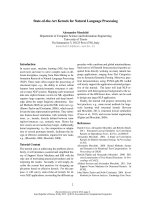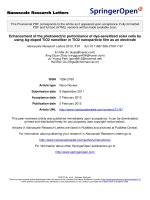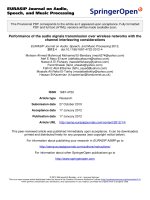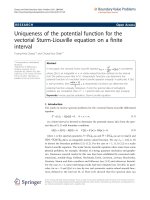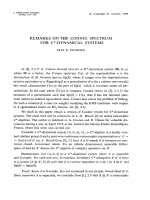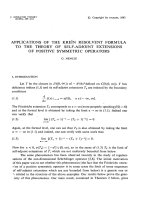Báo cáo toán học: " Proof of the Alon-Tarsi Conjecture for n = 2r p" docx
Bạn đang xem bản rút gọn của tài liệu. Xem và tải ngay bản đầy đủ của tài liệu tại đây (98.91 KB, 5 trang )
Proof of the Alon-Tarsi Conjecture for n =2
r
p
Arthur A. Drisko
National Security Agency
Fort George G. Meade, MD 20755
Submitted: April 10, 1998; Accepted: May 10, 1998.
Abstract
The Alon-Tarsi conjecture states that for even n, the number of even latin
squares of order n differs from the number of odd latin squares of order n.
Zappa [6] found a generalization of this conjecture which makes sense for odd
orders. In this note we prove this extended Alon-Tarsi conjecture for prime or-
ders p. By results of Drisko [2] and Zappa [6], this implies that both conjectures
are true for any n of the form 2
r
p with p prime.
1 Introduction
A latin square L of order n is an n × n matrix whose rows and columns are permu-
tations of n symbols, say 0, 1, ,n−1. Rows and columns will also be indexed by
0, 1, ,n−1. The sign sgn(L)ofLis the product of the signs (as permutations) of
the rows and columns of L. L is even, respectively odd , if sgn(L) is +1, respectively
−1. A fixed diagonal latin square has all diagonal entries equal to 0.
We denote the set of all latin squares of order n by LS(n) and the set of all fixed
diagonal latin squares of order n by FDLS(n). We denote the numbers of even, odd,
fixed diagonal even, and fixed diagonal odd latin squares of order n by els(n), ols(n),
fdels(n), and fdols(n), respectively.
If n = 1 is odd, then switching two rows of a latin square alters its sign, so
els(n)=ols(n). On the other hand, Alon and Tarsi [1] conjectured:
Conjecture 1 (Alon-Tarsi) If n is even then els(n) =ols(n).
Equivalently, the sum of the signs of all L ∈ LS(n) is nonzero. This conjecture is
related to several other conjectures in combinatorics and linear algebra [3, 5].
Zappa was able to generalize this conjecture to the odd case by defining the Alon-
Tarsi constant
AT(n)=
fdels(n) − fdols(n)
(n − 1)!
. (1)
MR Subject Classification (1991): 05B15, 05E20, 05A15
the electronic journal of combinatorics 5 (1998) #R28 2
Since any latin square can be transformed into a fixed diagonal latin square by a
permutation of rows, and since permuting rows does not change the sign of a latin
square of even order, we have
els(n) − ols(n)=
n!(n − 1)! AT(n)ifnis even
0ifnis odd.
(2)
Only a few values of AT(n) are known [4, 6]:
n 2 3 4 5 6 7 8
AT(n) 1 −1 4 −24 2, 304 368, 640 6, 210, 846, 720
Zappa conjectured this generalization of the Alon-Tarsi conjecture:
Conjecture 2 (Extended Alon-Tarsi) For every positive integer n,
AT(n) =0.
Aside from the table of known values, we have the following information about AT(n)
[2, 6]:
Theorem 1 (Drisko) If p is an odd prime, then
els(p +1)−ols(p +1)≡(−1)
p+1
2
p
2
(mod p
3
).
This implies that AT(p +1)≡(−1)
p+1
2
(mod p), by (2).
Theorem 2 (Zappa) If n is even, then
AT(n) =0=⇒AT(2n) =0,
and if n is odd, then
AT(n) =0and AT(n +1)=0=⇒AT(2n) =0.
Together, these imply the truth of the Alon-Tarsi conjecture for n =2
r
(p+1) for
any r ≥ 0 and any odd prime p (and, by the table of known values, for p =2also).
Our goal here is to prove that AT(p) = 0 for all primes p. This then implies that
the extended Alon-Tarsi conjecture is true for all n =2
r
p,wherer≥0andpis any
prime.
2 The Result
The approach is the same as in [2]. Let S
n
be the symmetric group on {0, 1, ,n−1}
and let
n
= S
n
× S
n
× S
n
. This group acts on the set LS(n)oflatinsquaresoforder
nby permuting the rows, columns, and symbols, and is called the isotopy group.
Let G be any subgroup of
n
. We shall call two latin squares L, M of order n
G-isotopic if there exists g ∈ G such that Lg = M. The orbit LG of L under G is
the electronic journal of combinatorics 5 (1998) #R28 3
the G-isotopy class of L.TheG-autotopism group
G
(L)ofLis the stabilizer of L
in G. Clearly
|G| = |LG||
G
(L)| (3)
for any G<
n
and any latin square L of order n.
We need one well-known lemma (see [2] or [4]).
Lemma 3 Let L be any latin square of order n and g =(α, β, γ) ∈
n
. Then
sgn(Lg)=sgn(α)
n
sgn(β)
n
sgn(γ)
2n
sgn(L)=sgn(α)
n
sgn(β)
n
sgn(L).
We are now ready for our main result.
Theorem 4 Let p be an odd prime. Then
AT(p) ≡ (−1)
p−1
2
(mod p). (4)
Proof.Let
G={(σ, σ, τ):σ, τ ∈ S
p
, 0τ =0}. (5)
G acts on FDLS(p). By Lemma 3, sgn(Lg)=sgn(L) for any L of order p and any
g ∈ G.LetRbe any set of representatives of the orbits of G in FDLS(p), and let S
be a set of representatives of those orbits of size not divisible by p.Then
fdels(p) − fdols(p)=
L∈FDLS(p)
sgn(L), (6)
=
L∈R
|LG|sgn(L), (7)
≡
L∈S
|LG|sgn(L)(modp). (8)
Since |G| = p!(p − 1)!, |LG| is not divisible by p if and only if p divides |
G
(L)|.
Suppose p divides |
G
(L)| for some L. Then there is some G-autotopism g =
(σ, σ, τ )ofLof order p.Sinceτ∈S
p
fixes 0, τ
p
= e implies that τ = e.Sincegis
not the identity, σ
p
= e implies that σ is a p-cycle, so that ρ
−1
σρ =(01 ··· p−1)
for some ρ ∈ S
p
.ThenM=L(ρ, ρ, e)isG-isotopic to L and has G-autotopism
((0 1 ··· p−1), (0 1 ··· p−1),e). It is clear that such an M must have constant
diagonals (that is, M
i,j
= M
i+1,j+1
for all i, j, taken mod p). But then there is some
µ ∈ S
p
, fixing 0, such that N = M(e, e, µ), where N is the square given by N
i,j
= i−j
(mod p). Hence any L with G-autotopism group divisible by p is G-isotopic to N,
so there is only one isotopy class in the sum (8), and its size is not divisible by p.
Therefore,
fdels(p) − fdols(p) ≡|NG|sgn(N)(modp). (9)
the electronic journal of combinatorics 5 (1998) #R28 4
Now, the columns of N, as permutations, are powers of the p-cycle φ =(01 ··· p−1),
so they all have positive sign. Each row, as a permutation, consists of one fixed point
and (p − 1)/2 transpositions, and there are an odd number of rows, so
sgn(N)=(−1)
p−1
2
. (10)
To determine |NG|,letg=(σ, σ, τ ) ∈
G
(N). We know that h =(φ, φ, e) ∈
G
(N),
so for some k, gh
k
=(σφ
k
,σφ
k
,τ) ∈
G
(N)andσφ
k
fixes 0. Then
iτ = N
i,0
τ
= N
iσφ
k
,0σφ
k
= N
iσφ
k
,0
= iσφ
k
for all i,sogh
k
=(τ,τ,τ). But then for all i, j ∈ Z
p
, the cyclic group of order p,we
have
(i − j)τ = N
i,j
τ
= N
iτ,jτ
=(iτ − jτ),
so τ must be an automorphism of Z
p
. Hence every G-autotopism of N is an auto-
morphism of Z
p
times a power of h and we have
|
G
(N)| = p|Aut(Z
p
)| = p(p − 1), (11)
and combining this with (3), we get
|NG| =
p!(p − 1)!
p(p − 1)
=(p−1)!(p − 2)! .
(12)
Finally, combining (9), (10), and (12), we have
AT(p)=
fdels(p) − fdols(p)
(p − 1)!
≡ (−1)
p−1
2
(p − 1)!(p − 2)!
(p − 1)!
(mod p)
≡ (−1)
p−1
2
(p − 2)! (mod p)
≡ (−1)
p−1
2
(mod p),
(13)
since (p − 2)! ≡ 1(modp), by Wilson’s theorem.
Let us record the known cases of the extended Alon-Tarsi conjecture as
Corollary 5 Let p be any prime and r any nonnegative integer. Then
AT(2
r
p) =0and AT(2
r
(p +1))=0.
Although the truth of the extended conjecture is still unknown for n = 9, the first
even value of n which is not of the form given in Corollary 5 is 50, whereas the
previous first unknown case of the original Alon-Tarsi conjecture was n = 22.
the electronic journal of combinatorics 5 (1998) #R28 5
References
[1] N. Alon and M. Tarsi, Coloring and orientations of graphs, Combinatorica
12 (1992), 125–143
[2] A. A. Drisko, On the number of even and odd latin squares of order p +1, Adv.
Math. 128 (1997), 20–35.
[3] R. Huang and G C. Rota, On the relations of various conjectures on Latin
squares and straightening coefficients, Discrete Math. 128 (1994), 237–245.
[4] J. C. M. Janssen, On even and odd latin squares, J. Combin. Theory Ser. A
69 (1995), 173–181.
[5] S. Onn, A colorful determinantal identity, a conjecture of Rota, and latin squares,
Amer. Math. Monthly 104 (1997), 156–159.
[6] P. Zappa, The Cayley determinant of the determinant tensor and the Alon-Tarsi
conjecture, Adv. Appl. Math. 19 (1997), 31–44.

